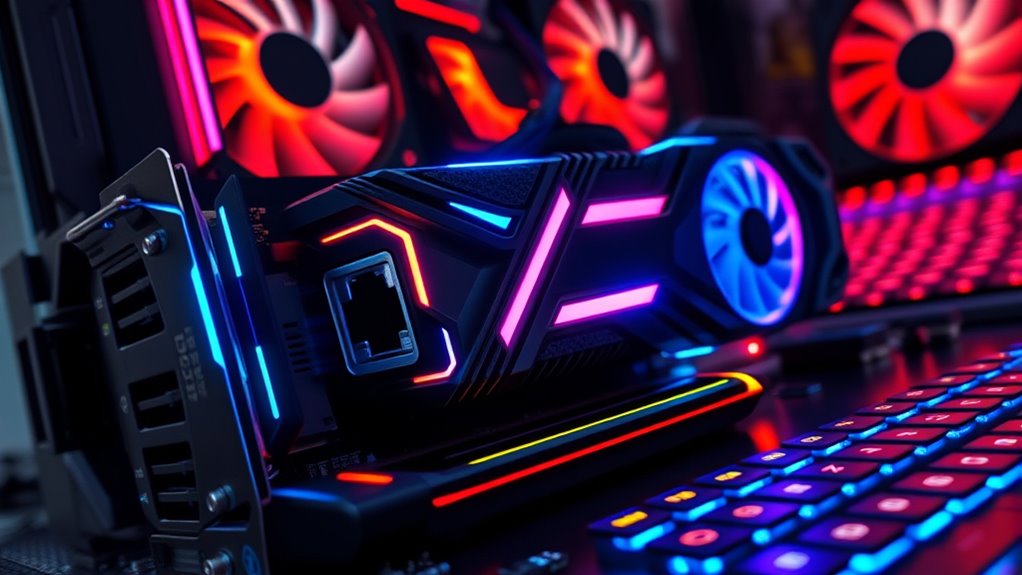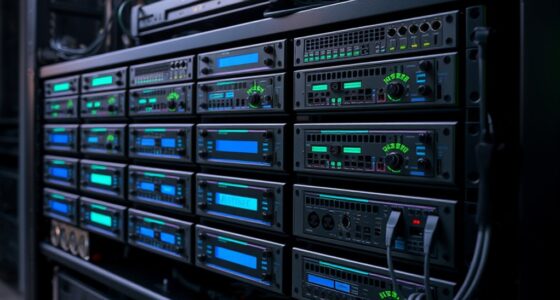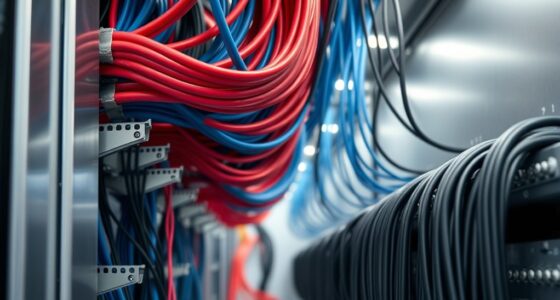If you’re looking for the best high-end network cards for gaming in 2025, I recommend options like WiFi 6E PCIe cards for ultra-fast speeds and low latency, and 10Gbps Ethernet cards for stable wired connections. These models support advanced tech like OFDMA, MU-MIMO, and multi-gigabit Ethernet, perfect for smooth gaming and streaming. Stay tuned to find out which options offer the best performance and compatibility for your setup.
Key Takeaways
- High-end gaming network cards support Wi-Fi 6/6E with gigabit and multi-gigabit Ethernet for ultra-fast, low-latency connections.
- They feature advanced technologies like OFDMA, MU-MIMO, and WPA3 for improved stability, security, and network efficiency.
- Compatibility with PCIe x1, x8, or x16 slots ensures seamless integration with modern gaming PCs.
- External antennas and magnetic bases provide enhanced signal coverage and stability during intense gaming sessions.
- They offer plug-and-play installation with driver support for Windows, Linux, and other OS, ensuring easy setup and top performance.
TP-Link WiFi 6E PCIe WiFi Card for PC
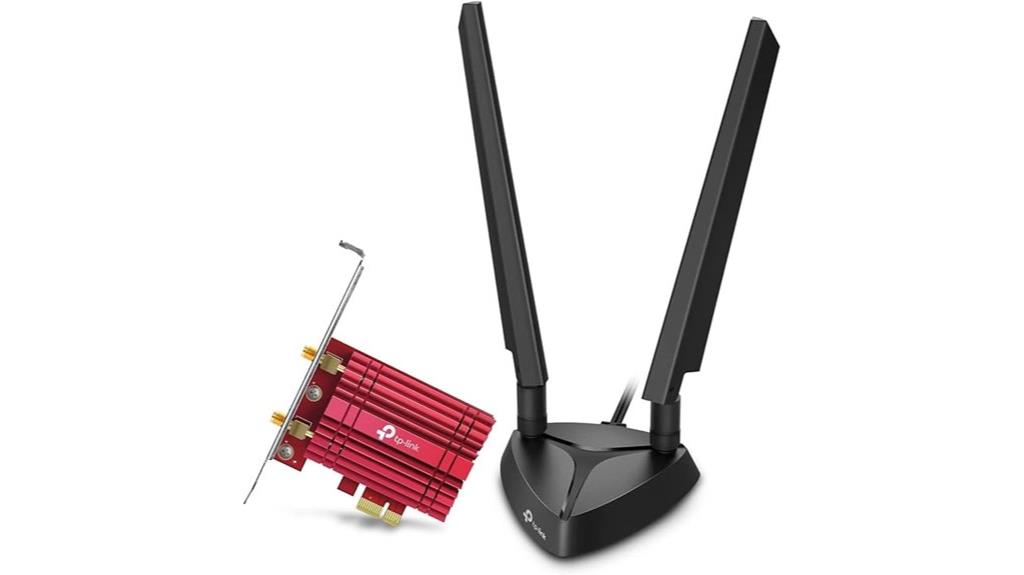
If you’re serious about gaming and want the best wireless performance, the TP-Link WiFi 6E PCIe WiFi Card is an excellent choice. It supports Wi-Fi 6E, offering speeds up to 2402 Mbps on the 6 GHz band, plus 5 GHz and 2.4 GHz connections for versatility. Equipped with the Intel AX210 chipset, it ensures low latency and stable connections, perfect for gaming and streaming. The card features dual high-performance antennas with magnetic bases for maximum coverage and flexible placement. Installation is straightforward—just slot it into your PCIe port and connect the Bluetooth cable. Overall, it’s reliable, future-proof, and rated highly by users for speed and stability.
Best For: gamers, streamers, and power users seeking high-speed, reliable wireless connectivity for PC with support for Wi-Fi 6E and low latency performance.
Pros:
- Supports Wi-Fi 6E with speeds up to 2402 Mbps on the 6 GHz band for future-proof performance
- Easy installation with PCIe slot compatibility and magnetic antennas for flexible placement
- Offers robust security features including WPA3 and Bluetooth 5.3 for fast, stable connections
Cons:
- Requires Windows 11 for 6 GHz Wi-Fi functionality, limiting compatibility with older OS
- Bluetooth activation involves connecting a USB cable and potential firmware updates
- Some users report driver update or permission issues on Windows 11 during setup
TP-Link 10GB PCIe Network Card (TX401)

The TP-Link 10GB PCIe Network Card (TX401) stands out as an excellent choice for gamers and power users who demand ultra-fast, reliable internet connections. Supporting 10 Gbps Ethernet via 10GBase-T, it’s ten times faster than standard Gigabit cards, ideal for high-bandwidth tasks, local transfers, and smooth gaming. It auto-negotiates across multiple speeds, ensuring compatibility with various networks, and includes a free CAT6A cable rated for 10 Gbps. Designed with durability, it supports both full-height and low-profile setups, with QoS features for prioritizing gaming traffic. Easy to install and compatible with Windows and Linux, the TX401 provides top-tier performance at a solid value.
Best For: gamers, power users, and professionals requiring ultra-fast, reliable 10Gbps Ethernet connections for high-bandwidth tasks and seamless data transfers.
Pros:
- Supports 10 Gbps Ethernet speeds with auto-negotiation across multiple network standards.
- Compatible with Windows and Linux systems, with easy plug-and-play installation.
- Includes both full-height and low-profile brackets for versatile PC case compatibility.
Cons:
- Achieving maximum speeds requires high-quality cabling and proper system configuration.
- May require driver updates or BIOS adjustments on older hardware for optimal performance.
- Slightly more expensive than standard Gigabit network cards, though justified by performance.
TP-Link 2.5GB PCIe Network Card

For gamers seeking lightning-fast internet connections, the TP-Link 2.5GB PCIe Network Card stands out with its impressive 2.5Gbps data transfer speed. Supporting 2.5G Base-T technology, it delivers over 2.5 times faster speeds than standard Gigabit Ethernet, ensuring smooth gameplay and quick data transfers. Compatible with Windows, Linux, and Windows Server, it’s versatile and easy to install with plug-and-play functionality. The card automatically adjusts between 2.5 Gbps, 1 Gbps, and 100 Mbps, making it adaptable to various setups. With solid build quality, reliable connectivity, and a 2-year warranty, it’s a cost-effective upgrade for high-performance gaming networks.
Best For: gamers and high-performance users seeking a reliable, high-speed network upgrade for fast internet and data transfers.
Pros:
- Supports blazing-fast 2.5Gbps data transfer speeds for smooth gaming and quick data sharing
- Compatible with Windows, Linux, and Windows Server, ensuring broad system support
- Easy plug-and-play installation with automatic speed negotiation for versatile setups
Cons:
- May require driver updates or adjustments for optimal Windows performance and stability
- Some users experience connectivity issues related to sleep mode or driver compatibility
- Full 2.5Gbps speeds depend on compatible routers and network infrastructure
TP-Link 10GB PCIe Network Card (TX401)
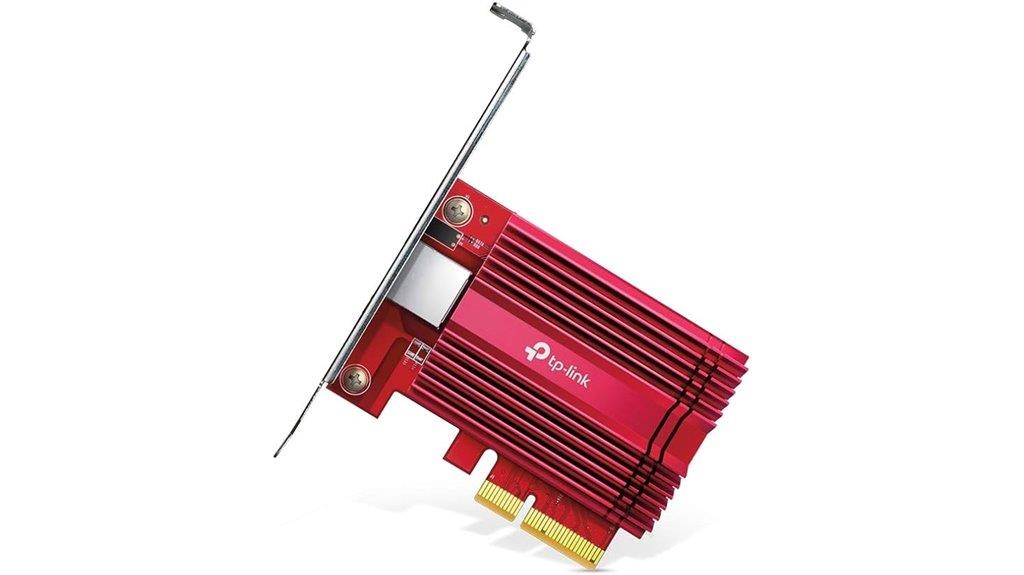
With support for up to 10 Gbps Ethernet speeds, the TP-Link TX401 stands out as the ideal choice for gamers and power users who demand ultra-fast local data transfers and minimal latency. Its PCIe 3.0 interface and 10GBase-T technology enable speeds far beyond standard Gigabit adapters, perfect for large file transfers and streaming. The card supports multi-speed auto-negotiation, ensuring compatibility and smooth upgrades. It includes a high-quality CAT6A cable rated for 10 Gbps, along with both low-profile and full-height brackets for versatile PC builds. Easy to install and compatible with Windows and Linux, the TX401 offers reliable, high-performance networking for demanding gaming and professional setups.
Best For: gamers, power users, and professionals seeking ultra-fast local network speeds and reliable high-bandwidth connections.
Pros:
- Supports ultra-fast 10 Gbps Ethernet speeds with 10GBase-T technology.
- Compatible with Windows and Linux systems, ensuring broad usability.
- Includes both low-profile and full-height brackets for versatile PC installation.
Cons:
- Achieving maximum speeds may require proper cabling and system configuration.
- Driver updates and system compatibility should be verified for older hardware.
- Slightly higher cost compared to standard Gigabit network cards, but justified by performance.
TP-Link WiFi 6 PCIe WiFi Card for Desktop PC (Archer TX55E)
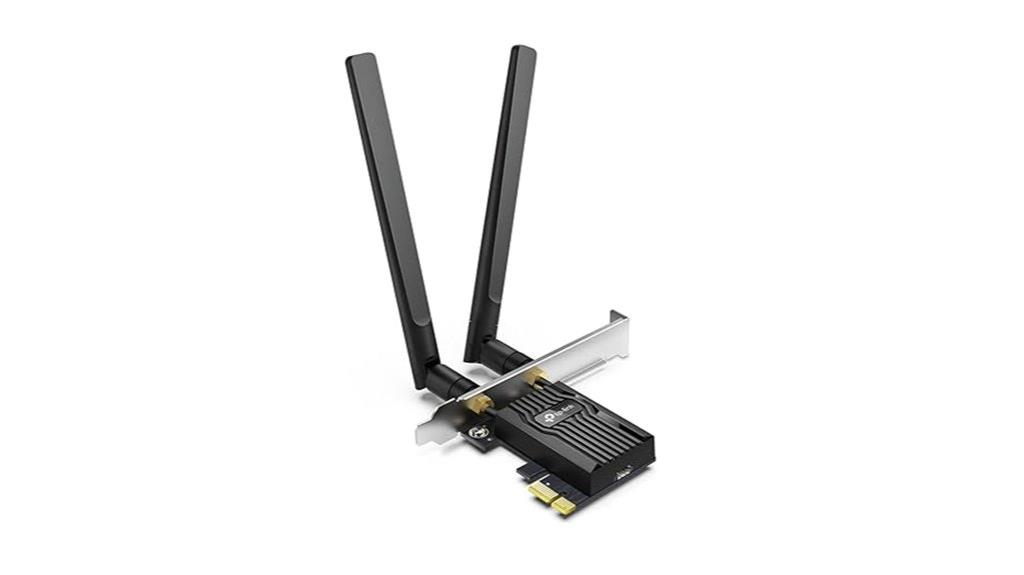
If you’re seeking a high-performance network card that can handle demanding gaming and streaming, the TP-Link Archer TX55E stands out with its Wi-Fi 6 technology delivering speeds up to 2.4 Gbps. It supports MU-MIMO, OFDMA, WPA3 security, and Bluetooth 5.2, ensuring fast, secure, and low-latency connections. Equipped with two high-gain antennas, it offers excellent coverage for smooth online gameplay. Compatibility extends to Windows 10 and 11, though driver setup may require some effort. With real-world speeds often surpassing 1 Gbps, it’s a reliable choice for gamers wanting top-tier wireless performance in a compact, durable design.
Best For: gamers, streamers, and power users seeking high-speed, secure, and reliable Wi-Fi 6 connectivity for desktop PCs.
Pros:
- Supports Wi-Fi 6 technology with speeds up to 2.4 Gbps for optimal performance
- Includes high-gain antennas for broader coverage and stable connections
- Features WPA3 security and Bluetooth 5.2 for enhanced safety and peripherals
Cons:
- Driver installation can be finicky and may require manual updates
- May need additional driver setup, especially on Linux systems
- Requires connecting a USB header for Bluetooth functionality, adding complexity to installation
TP-Link WiFi 6 AX3000 PCIe WiFi Card (Archer TX3000E)

The TP-Link WiFi 6 AX3000 PCIe WiFi Card (Archer TX3000E) stands out as an excellent choice for gamers seeking ultra-fast, low-latency wireless connections. It supports Wi-Fi 6, delivering speeds up to 2.4 Gbps with 1024-QAM and 160 MHz bandwidth, perfect for gaming and streaming. The dual high-performance antennas and magnetized base improve coverage and signal stability. Bluetooth 5.3 adds reliable peripheral connectivity with faster speeds and broader range. Easy to install with straightforward drivers, the card is compatible with Windows 10, 11, and Linux. Overall, it’s a future-proof upgrade for high-bandwidth, stable gaming experiences.
Best For: gamers and high-bandwidth users seeking ultra-fast, low-latency Wi-Fi and reliable peripheral connections for demanding online activities.
Pros:
- Supports Wi-Fi 6 with speeds up to 2.4 Gbps, ideal for gaming and streaming
- Easy plug-and-play installation with compatible drivers for Windows and Linux
- Dual high-performance antennas with magnetized base enhance coverage and signal stability
Cons:
- Bluetooth functionality requires connection to USB header via cable, which may add complexity
- Driver updates may be needed for optimal Windows 11 performance
- Larger size and additional components might require careful installation in compact cases
10G PCI-E Network Card with Dual RJ45 Ports

A G PCI-E Network Card with Dual RJ45 Ports is ideal for gamers and high-end users who demand blazing-fast, reliable network connections. With dual 10Gbps ports powered by the Intel X540-T2 chipset, it delivers up to 10Gbps speeds, perfect for high-performance gaming, streaming, or data-intensive tasks. It supports multiple operating systems like Windows, Linux, and VMware, ensuring versatile compatibility. Designed for PCIe x8 and x16 slots, installation is flexible across various systems. Its heat sink and gold finger interface promote stability and reduce interruptions, maintaining consistent performance even during intensive network activity. This card is a top choice for demanding high-end setups.
Best For: high-end gamers, data centers, and professionals requiring ultra-fast, reliable network connections for demanding applications.
Pros:
- Supports up to 10Gbps speeds with dual RJ45 ports, ensuring fast data transfer.
- Compatible with multiple operating systems including Windows, Linux, and VMware for versatile deployment.
- Features heat sink and gold finger interface for enhanced stability and reduced interruptions during intensive use.
Cons:
- Requires PCIe x8 or x16 slots, which may not be available in all systems.
- Installation may be more complex for users unfamiliar with hardware upgrades.
- Higher cost compared to standard network cards with lower speeds.
WiFi 6 PCIe Card with Bluetooth 5.2 for Gaming PC

For gamers seeking ultra-fast, stable wireless connections, the WiFi 6 PCIe Card with Bluetooth 5.2 stands out as an excellent upgrade option. It delivers speeds up to 3000Mbps, ideal for gaming, streaming, and VR. Its OFDMA and MU‑MIMO technologies cut latency, ensuring smooth real-time gameplay even on busy networks. The dual antennas boost coverage, reducing dead zones. Bluetooth 5.2 offers faster pairing and broader peripheral support, like controllers and headsets. Easy to install, it connects via PCIe and includes a Bluetooth cable. With WPA3 security and broad Windows compatibility, this card enhances both performance and convenience for high-end gaming setups.
Best For: gamers and streamers seeking a high-performance WiFi and Bluetooth upgrade for their gaming PC to ensure fast, stable, and low-latency connectivity.
Pros:
- Supports WiFi 6 speeds up to 3000Mbps for seamless gaming and streaming.
- Equipped with dual high-gain antennas for extended Wi-Fi coverage and reduced dead zones.
- Bluetooth 5.2 enables faster pairing and broader peripheral compatibility, enhancing device connectivity.
Cons:
- Driver installation on Windows 10 may require troubleshooting or additional steps.
- Requires a free PCIe slot and physical installation inside the PC, which may be complex for some users.
- Limited to Windows 10 and 11, not compatible with older operating systems.
TP-Link AC1200 PCIe WiFi Card for Desktop PC

If you’re upgrading your gaming PC for faster, more stable wireless connections, the TP-Link AC1200 PCIe WiFi Card is an excellent choice. It delivers up to 1200 Mbps total speeds, with 867 Mbps on 5 GHz and 300 Mbps on 2.4 GHz bands, ensuring smooth gameplay and streaming. Its high-gain antennas improve coverage and stability, while Bluetooth 5.0 allows seamless pairing with controllers and peripherals. Easy to install via PCI-E slot, it supports Windows 10 and 11, and features WPA3 security for data protection. Overall, this card combines speed, reliability, and security, making it a perfect upgrade for high-performance gaming setups.
Best For: gamers and high-bandwidth users seeking a reliable, high-speed wireless and Bluetooth upgrade for their desktop PC.
Pros:
- Supports high-speed dual-band Wi-Fi up to 1200 Mbps for smooth gaming and streaming
- Includes Bluetooth 5.0 for easy connection with peripherals and controllers
- Easy installation with PCI-E slot compatibility and adjustable brackets
Cons:
- Requires connection of Bluetooth USB cable to F_USB connector for Bluetooth functionality
- External antennas may require additional space or adjustments for optimal coverage
- Only compatible with Windows 10 and 11, limiting use on older operating systems
GIGABYTE WiFi 6E PCIe Expansion Card
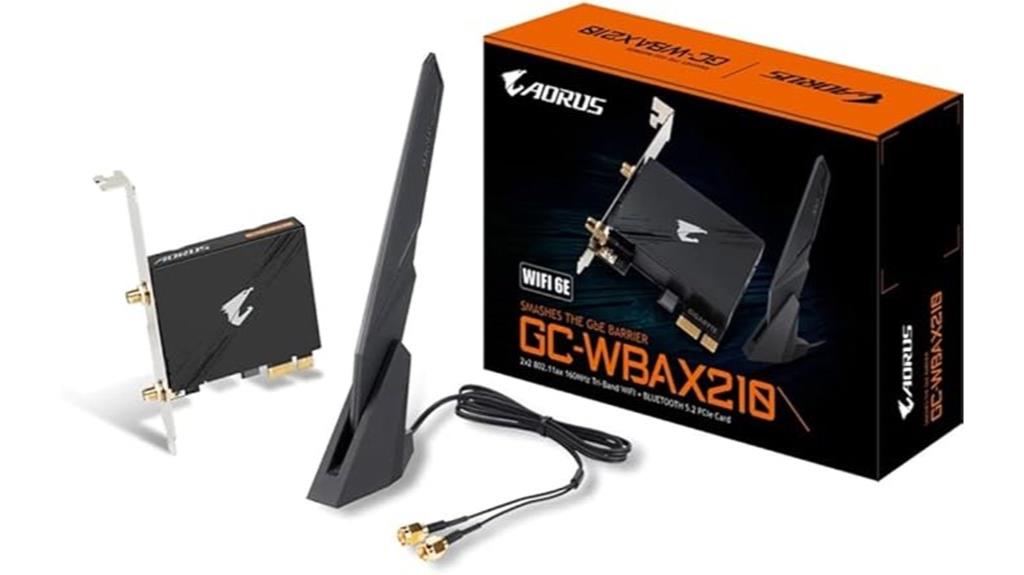
The GIGABYTE WiFi 6E PCIe Expansion Card stands out for gamers who demand ultra-fast, low-latency wireless connections, thanks to its support for tri-band WiFi, including the dedicated 6GHz spectrum. Equipped with the Intel Wi-Fi 6E AX210 module, it offers speeds up to 2400Mbps across 2.4GHz, 5GHz, and 6GHz bands. The 2×2 WiFi configuration enhances stability and performance, while Bluetooth 5.2 adds versatile connectivity options. Its compatibility with IEEE 802.11.acR2plusax guarantees reliable, high-speed connections, making it a top choice for achieving top-tier network performance in gaming setups.
Best For: gamers and high-performance PC users seeking ultra-fast, low-latency wireless connectivity with tri-band support and reliable Bluetooth 5.2 features.
Pros:
- Supports tri-band WiFi (2.4GHz, 5GHz, 6GHz) for maximum speed and reduced interference
- High-speed wireless connection up to 2400Mbps ensures smooth gaming and streaming
- Built-in Intel Wi-Fi 6E AX210 module and 2×2 WiFi configuration for enhanced stability and performance
Cons:
- Requires a PCIe slot and proper installation in the PC, which may be challenging for some users
- May be more expensive than standard WiFi expansion cards due to advanced features
- Compatibility depends on motherboard support for WiFi 6E and PCIe slots
BrosTrend 5Gb PCIe Network Card
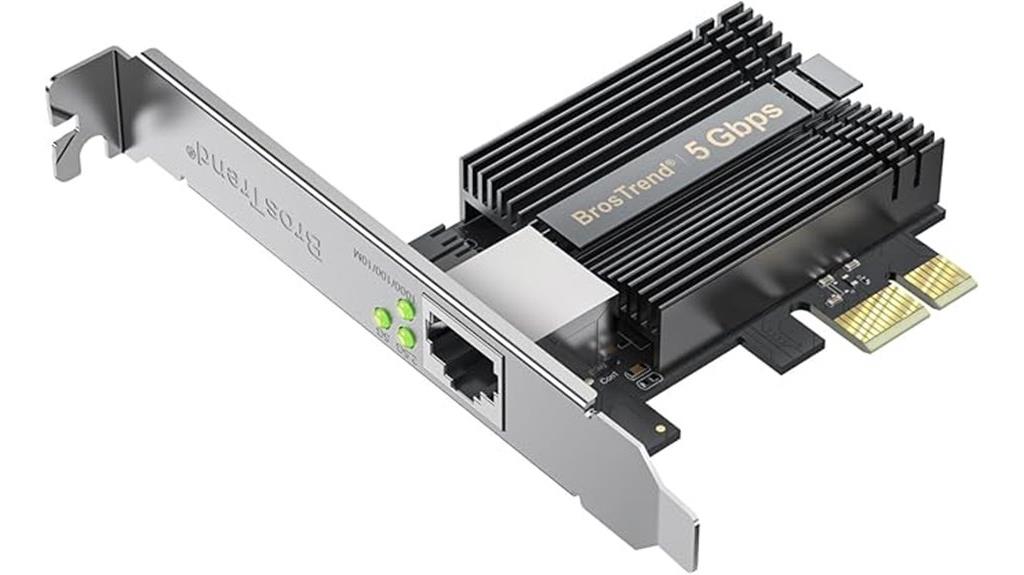
The BrosTrend 5Gb PCIe Network Card stands out as an excellent upgrade for gamers and power users who demand blazing-fast, reliable wired connections. With speeds exceeding 2Gbps and support for 5GBASE-T technology, it guarantees minimal latency and top responsiveness. Its plug-and-play setup makes installation quick, while driver updates optimize performance, especially on Windows 11 and 10. Built with high-quality aluminum for heat dissipation, it offers consistent, stable connectivity for gaming, streaming, and large file transfers. Rated 4.5 stars from hundreds of reviews, many users praise its affordability and ease of use, making it a cost-effective solution for high-speed networking needs.
Best For: gamers and power users seeking ultra-fast, reliable wired internet connections with easy installation and future-proof performance.
Pros:
- Supports speeds exceeding 2Gbps with stable 5Gbps throughput, ideal for high-speed internet and data transfer.
- Plug-and-play setup with quick installation and driver support for Windows 11 and 10.
- High-quality aluminum build ensures effective heat dissipation and reliable connectivity.
Cons:
- Initial connection issues or speed caps at 2.5Gbps may occur without proper driver installation.
- Linux support is limited, requiring kernel 6.9+ with no dedicated Linux drivers provided.
- Some users have experienced connectivity hiccups on certain motherboards, necessitating manual driver configuration.
Factors to Consider When Choosing a High‑End Network Card for Gaming

When selecting a high-end network card for gaming, I consider several key factors to guarantee peak performance. I look at speed and bandwidth needs, compatibility with my setup, and whether I should choose wired or wireless options. Security features and ease of installation also play a big role in making the right choice.
Speed and Bandwidth Needs
Choosing a high-end gaming network card requires careful attention to speed and bandwidth needs, as these factors directly impact your gaming experience. Most top-tier cards support speeds of 1 Gbps or higher, with premium models reaching up to 10 Gbps for ultra-fast data transfer. Your bandwidth requirements depend on the game’s data demands; modern AAA titles often need at least 100 Mbps for smooth multiplayer and streaming. To future-proof your setup, look for cards supporting multi-gigabit speeds like 2.5 Gbps, 5 Gbps, or 10 Gbps, ensuring compatibility with increasing internet speeds. High bandwidth also enhances activities like 4K streaming, VR gaming, and large file transfers, helping reduce lag, buffering, and latency during intense online sessions.
Compatibility With Devices
Ensuring your high-end gaming network card is compatible with your device’s hardware and software is essential for peak performance. First, check that the card supports your motherboard’s interface, usually PCIe x1 or x16 slots, to guarantee it fits properly. Next, verify that the card’s operating system requirements match your device’s OS, whether Windows 10, Windows 11, or Linux. Additionally, look for the necessary connectors and headers, like USB headers for Bluetooth or Wi-Fi antennas, so everything connects seamlessly. The card’s form factor is also vital—make sure it fits within your case, especially if you have a smaller or low-profile setup. Lastly, verify the hardware specs, such as bandwidth support (e.g., 2.5Gbps or 10Gbps), align with your networking needs and device capabilities.
Wireless vs. Wired Options
Wireless network cards offer the convenience of a cable-free setup, making them ideal for flexible gaming arrangements or rooms where running Ethernet cables is impractical. However, they can experience higher latency and signal interference, which may impact real-time gameplay. Wired connections generally provide more stable and consistent speeds, often reaching the full bandwidth of the Ethernet cable—crucial for competitive gaming. Technologies like Wi-Fi 6E and Bluetooth 5.3 have improved wireless performance but still typically can’t match the low latency of a wired connection. Physical obstacles, distance, and interference can disrupt wireless signals, whereas wired networks eliminate these issues, ensuring reliable, latency-minimized connectivity. Ultimately, your choice depends on room layout, mobility needs, and how important minimizing lag is for your gaming experience.
Security and Privacy Features
As gaming setups become more sophisticated, security and privacy features on high-end network cards are gaining significance. I look for cards supporting advanced protocols like WPA3, which offers stronger encryption and better protection against hacking attempts. Features like secure boot and firmware integrity checks are vital—they prevent unauthorized access and keep the firmware tamper-proof. Hardware-based security options, such as integrated firewalls and VPN support, help control data flow and encrypt traffic directly at the device level, boosting privacy. Additionally, support for privacy-focused technologies like MAC address randomization and VLAN segmentation helps prevent tracking and unauthorized network access. Regular driver updates and compatibility with current security standards ensure I stay protected against emerging cyber threats, making security a top priority when choosing a high-end gaming network card.
Installation and Setup Ease
Choosing a high-end network card for gaming becomes much easier when it offers straightforward installation and setup. Look for cards with plug-and-play compatibility and minimal driver requirements, which save time and reduce frustration. Cards supporting both PCIe x1 and x16 slots, along with included standard and low-profile brackets, make physical installation simple in different cases. Clear, user-friendly driver installation processes—preferably with automatic recognition in Windows—help speed up setup and configuration. Features like magnetic antennas or quick-connect ports streamline antenna placement and improve signal quality with less effort. Well-designed cards often come with detailed setup guides or driver support resources, making initial installation smooth and hassle-free. These factors ensure you spend more time gaming and less time troubleshooting.
Frequently Asked Questions
How Do High-End Network Cards Improve Gaming Latency and Jitter?
High-end network cards improve gaming latency and jitter by providing faster, more stable connections and reducing lag spikes. I’ve noticed that they prioritize data transfer, minimize packet loss, and offer advanced features like QoS, which guarantees my gaming traffic gets priority. This means smoother gameplay, less delay, and a more consistent experience overall. Upgrading to a top-tier card really makes a noticeable difference in competitive and fast-paced games.
Are There Compatibility Issues With Specific Motherboard Chipsets?
Did you know that over 60% of gamers report compatibility issues with certain motherboard chipsets? I’ve found that some high-end network cards work perfectly with newer chipsets like Z790, but older ones like X370 can pose problems. It’s essential to verify your motherboard’s compatibility before buying. I always recommend visiting the manufacturer’s website or forums to ensure your network card will work smoothly with your specific motherboard.
What Is the Typical Lifespan of a Premium Gaming Network Card?
A premium gaming network card typically lasts around 3 to 5 years, depending on usage and technological advancements. I’ve found that with proper care and regular driver updates, it can stay relevant longer. However, as newer standards emerge, upgrading might be necessary to keep up with the latest speeds and stability. So, I recommend keeping an eye on performance and tech trends to know when it’s time for an upgrade.
Can These Cards Support Future Wi-Fi Standards Beyond Wi-Fi 6E?
Yes, some high-end network cards can support future Wi-Fi standards beyond Wi-Fi 6E. While many current cards are built for today’s tech, manufacturers are designing newer models with future-proofing in mind, including compatibility with upcoming standards like Wi-Fi 7. I recommend checking the specifications carefully, as support for future standards depends on the hardware’s chipset and firmware updates—staying ahead means choosing cards with flexible, upgrade-friendly designs.
Do High-End Network Cards Require Special Drivers or Software Updates?
Yes, high-end network cards usually need specific drivers to run effectively, especially for maximum performance and stability. I always make sure to keep the drivers updated through the manufacturer’s website or software tools. Sometimes, updates fix bugs or add support for new Wi-Fi standards. Staying current guarantees I get the best speeds, reliability, and compatibility with my gaming setup.
Conclusion
Choosing the right high-end network card is like upgrading to a sports car — the speed and stability transform your gaming experience. I once switched to a 10Gb card, and my lag vanished, making every match feel like a smooth race. With these top options, you’ll enjoy lightning-fast connections and rock-solid stability that keep you ahead of the competition. Invest wisely, and your gaming world will never hit a slowdown again.
